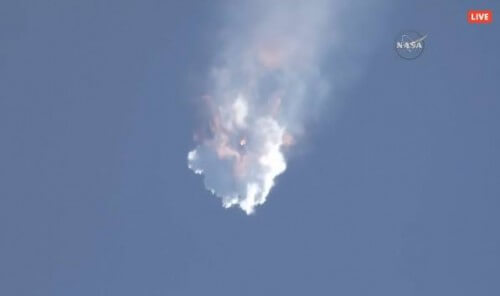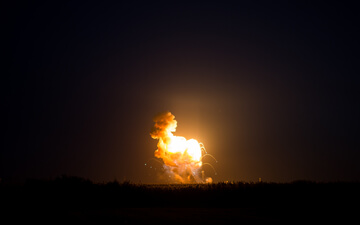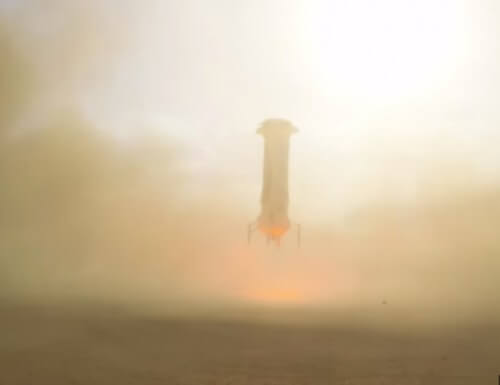The year 2015 was full of failures in supply launches to the space station. The manufacturers draw lessons
From Failures to Successes: The Year of NASA and the Commercial Space Companies

It was a year full of setbacks. It started back in October 2014 with the crash of the spacecraft Spaceship 2, which is developed by the company Virgin Galactic for suborbital flights of space tourism, and as a result of the accident one of the test pilots died. The investigation report He stated that the cause of the accident was human error by the co-pilot, but he criticized the company that built the spacecraft, for not addressing the human error factor in its development. A few days earlier the launch of the launcher failed Entres Of the company Orbital A.T.K and on top of it the cargo spacecraft Cygnus, designed to bring supplies to the International Space Station. May 2015 Russian cargo spacecraft Progress failed to reach the International Space Station, and in June a launch failed Falcon 9 Of the company Spice X who also carried a cargo spacecraft to the station, the spacecraft a dragon.

Failures are part of any development
These failures should not be surprising. The space field in general and the launch in particular are still fields with a high level of risk, despite decades of accumulated knowledge. Indeed, these failures did not stop anyone from testing and correcting the failures, and then continuing to move forward. Virgin Galactic has already started building a new model of Spaceship 2 and Orbital ATK has announced that it will replace the type of engine of the Hunter launcher that was responsible for the failure. To meet its obligations to NASA to send supplies to the International Space Station, the Cygnus spacecraft was launched using an alternate launcher in December of this year. SpaceX also returned to activity in December with the launch of Falcon 9 in an improved model.
The catastrophic failure of the Hunter launcher
Progress in the Orion project
And there was also a lot of progress this year. NASA continued to develop the multipurpose spacecraft Orion That it will be used for manned flights in deep space - and in the more distant future, at least that is what NASA says and hopes, to Mars as well. The launcher of the spaceship, with the somewhat banal name "Space launch system” (SLS) continues in rather accelerated development towards its first (unmanned) flight at the end of 2018, and this year a series of tests were conducted on its rocket engines and completed Comprehensive engineering examination of the launcher, a significant milestone on the way to building the launcher that according to NASA will be the most powerful ever (but only in an improved model that is not currently being developed). To reduce development costs, the launcher uses existing technology from the space shuttles, such as their main engines (NASA has 16 such engines left over from the space shuttle era).
Asteroid tilting mission
As part of its preparations to carry out manned missions in deep space - NASA is "looking" for future targets for these missions. One of them is "Asteroid tilting mission(Asteroid Redirect Mission). This year, NASA chose a final design for the mission profile - a spacecraft with an advanced and extremely powerful ion engine will reach a near-Earth asteroid, land on it and take a rock with a mass of several tons from it, which it will transfer to orbit around the moon (and before that, it will also perform a demonstration of a technique for tilting the asteroid's orbit , which can be used in the case of an asteroid that may collide with the Earth). According to the schedule of the mission proposal, in 2025 astronauts will reach the rock in orbit around the moon, where they will study it and return samples from it to Earth (see Simulation video of the task). It is worth noting that the mission has not yet received final approval from Congress, which did not show much enthusiasm for the mission.
Private manned spacecraft
The Orion spacecraft will only become operational in the early 20s, so until then the US will be dependent on Russia to send astronauts to the International Space Station, and with the intense tension that began following the Ukrainian crisis and continues now in Syria - it is likely that the US is not so happy with this situation . To end its dependence on Russia, NASA continues its plan to help commercial companies develop manned spacecraft. SpaceX is developing A manned model of the Dragon spacecraft, and this year revealed its internal design and performed a test flight of the escape system, which is designed to save the astronauts' lives in the event of a malfunction during launch. company Boeing It is also developing a manned spaceship, which this year received an official name - Starliner CST-100. According to the current schedule, the first manned launches of these spacecraft will begin in 2017, but only recently NASA signed a contract in the amount of about $500 million with the Russian space agency, to send astronauts aboard Soyuz spacecraft until 2019, and warned Congress that a reduced budget would cause a delay in the development schedule of these spacecraft.
Escape system test of the manned model of the Dragon spacecraft, May 2015. Source: SpaceX.

Perhaps one of the most impressive achievements of this year was The success of landing back a space launcher. This is a dramatic advance on the road to development Multipurpose space launchers Real ones, that will not be destroyed after each launch, something that will greatly reduce launch costs and make space more accessible. the first that succeeded To do this was a company Blue Origin, which develops the suborbital spacecraft "New Shepard". This spacecraft is intended for space tourism and only reaches the beginning of the official "border" of space, at an altitude of 100 km, where the space tourists will experience a few minutes of weightlessness, before the spacecraft falls back to earth. Soon after, it was a company Spice X that made headlines, with success that was perhaps much more important. Space X managed to return to Israel the first stage of Falcon 9, which launches spacecraft and satellites into an orbital path around the Earth, at a higher altitude than "New Shepard", which affects the speed, position and design of the launcher and makes it very difficult to return the first stage. Now it remains for these companies to show that it is indeed possible to use these missiles a second time, and in the process also to prove that the field of space does not belong only to the governmental space agencies of great powers.
Video: The return of the "New Shepard" launcher to Israel in a vertical landing. Source: Blue Origin.
In the legal field, the US Congress enacted this year youThe Commercial Space Law(Commercial Space Launch Competitiveness Act) which extends the "learning period" of commercial space companies, during which they are granted relief in safety restrictions, so that they can continue to develop their vehicles relatively freely. In addition, the law regulates possible future activity of mining resources in space from asteroids or any other celestial body (and there are already companies like Planetary Resources that are planning this), and extends the American commitment to the International Space Station until 2024.

One response
The thing that annoyed me the most in the article is the "commercial space law". They are already enacting laws that will regulate future mining in asteroids and we remembered to enact a law that regulates the issue of gas only after the license holders found commercial quantities and put the whole economy into a spin.